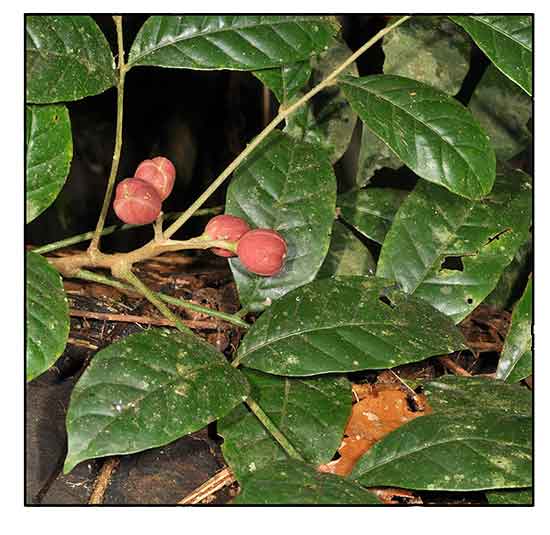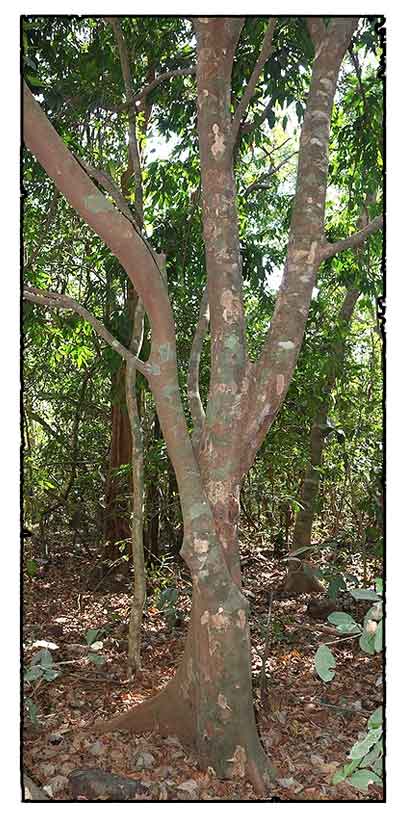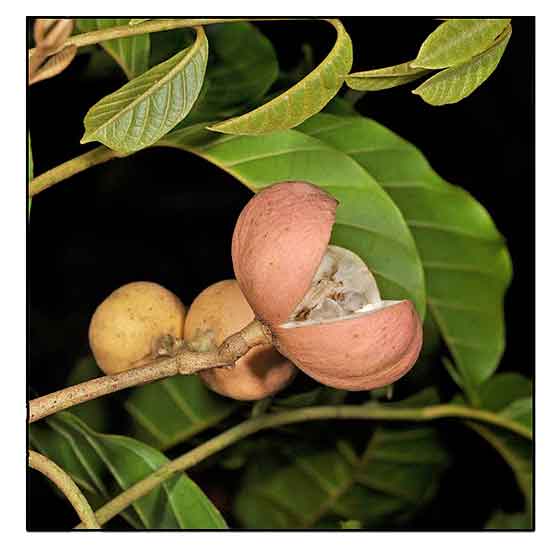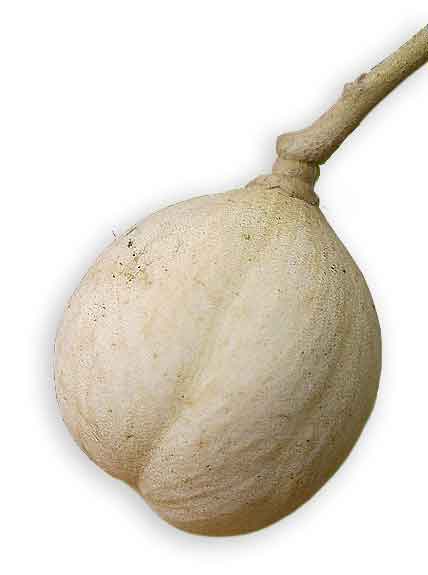 Gen info Gen info
- Aglaia lawii is a species of tree in the family Meliaceae.
- Plants of the World Online lists three accepted infraspecifics.
- The species was first described in 1976 by the Jesuit priest and botanist Cecil John Saldanha (1926/27-2002), in Flora of the Hassan District, Karnataka, India, a work co-edited with US botanist Dan Henry Nicolson and published in 1976. (3)
- Etymology: The taxa was originally described in 1846 as Nimmola lawii by Scottish surgeon and botanist Robert Wight (1796-1872). The species epithet lawii honors John Sutherland Law (1810-1855), a British civil servant in Mumbai. (3)
Botany
 • Species grows as a tree from 5 to 30m tall. Subspecies oligocarpa grows as a tree up to 30m tall and 40 cm diameter. Tree may flower when only around 2.5m tall. Buttresses may be present, up to 90 cm high. Bark may range in color from reddish-, dark-, grayish-, greenish-brown to gray, pale-green, pale-yellow or white, inner bark ranges in color from either pale green, yellow or orange-brown, to red, pink or white. The latex is white. Sapwood ranges from pale brown, to yellow and white, becoming pinker sometimes towards the heartwood. Its leaves are imparipinnate with a terete rachis. Indumentum has peltate scales, with a few to almost none on lower surface of leaflets. Fruit are subglobose. The differences to the autonym species are: the leaflets are less coriaceous with sparser indumentum. It is different to the closely related A. beccarii by: having an indumentum that is of peltate scales only; terete rachis that is not winged; when the seeds are dry the pericarp is not moulded around them. • Species grows as a tree from 5 to 30m tall. Subspecies oligocarpa grows as a tree up to 30m tall and 40 cm diameter. Tree may flower when only around 2.5m tall. Buttresses may be present, up to 90 cm high. Bark may range in color from reddish-, dark-, grayish-, greenish-brown to gray, pale-green, pale-yellow or white, inner bark ranges in color from either pale green, yellow or orange-brown, to red, pink or white. The latex is white. Sapwood ranges from pale brown, to yellow and white, becoming pinker sometimes towards the heartwood. Its leaves are imparipinnate with a terete rachis. Indumentum has peltate scales, with a few to almost none on lower surface of leaflets. Fruit are subglobose. The differences to the autonym species are: the leaflets are less coriaceous with sparser indumentum. It is different to the closely related A. beccarii by: having an indumentum that is of peltate scales only; terete rachis that is not winged; when the seeds are dry the pericarp is not moulded around them.
• Submonophylla subspecies grows as a small tree, no higher than 5m tall. Like the autonym species and the subspecies oligocarpa its indumentum is only of peltate scales; the leaf scales are few and mainly on the lower-leaflet-surface midrib; scales on the inflorescence are often with a fimbriate margin. The leaf rachis is not winged, it is terete. Unlike subspecies lawii (the autonym), it has simple leaves, though rarely leaves with two or three leaflets; and the leaves or leaflets are less coriaceous. The fruit has thin pericarp, and when dry it is moulded around the 1–3 seeds.
Distribution
- Native to the Philippines. (1)
- Occurs in primary and secondary evergreen to deciduous forests, from sea level up to 1,650 m altitude. (2)
- Also native to Andaman Is., Borneo, Cambodia, China South-Central, China Southeast, East Himalaya, Hainan, India, Laos, Malaya, Myanmar, Nicobar Is., Sumatera, Taiwan, Thailand, Tibet, Vietnam
. (1)
 Constituents Constituents
- Study of leaves isolated eleven previously uncharacterized steroids, along with three analogs. Compounds 1-3, 12 and 13 were C-21 pregnane steroids, compounds 4-11 and 14 were Δ5-3β-hydroxy-7-ketosteroids. (see study below) (5)
- Study of bark isolated a pregnane steroid, (E)-aglawone, along with four known triterpenes, and a known sterol mixture. (The isolates showed no activity against various human cancer cell lines.) (7)
-
GC-MS analysis of leaves for volatile organic matter yielded 12 compounds, with major constituents of 3,7-cyclodecadene-1-methanol,Veridiflorol,4,1-isopropyl-1,6-dimethyl-1,2,3, Cyclohexa methanol,4-ethenyl-α-α 4-trimethyl-, Globulol etc. (8)
- Study of branches and leaves isolated five undescribed steroids and one sesquiterpene, Aglaian A-F (1-6), along with 16 known analogs viz. (E)-aglawone (7), 2β,3β-oihydroxy-5α- pregn-l7(20)-(Z)-en-16-one (8), (Z)-toonasterone C (9), (E)-toonasterone C (10), ent-4(15)-eudesmene-1β,6α-diol (11), (+)-aphanamol I (12), 10a-hydroxycadin-4-en-15-al (13), 1-oxo-5α,7αH-eudesma-3-en-15-al (14), amouanglienoid A (15), aphanamol II (16), pancherio-ne (17), 1β-hydroxy-4(15),5E,10(14)-germacratriene (18), isodauc-6-ene-10β,14-diol (19), 4-epi-isodauc-6-ene-10β,14-diol (20), 15-hydroxy-α-cadinol (21), and commiphorane I (22) (see study below) (9)
- Study of branches and leaves isolated three undescribed limonoids (1-3), Aglaians G-I, and one new natural product, azedaralide (4), together with nine known analogues (5-13). (see study below) (11)
-
Nutritional analysis per 100 g dried material yielded energy value 218.0, proteins 15.4%, carbohydrates 38.7%, fats 0.2%, vitamin A 22,443.27, vitamin C 5.15, potassium 2.711, calcium 2.378, magnesium 0.26, phosphorus 0.145, iron 0.075, copper 0.0007, manganese 0.0051. Phytochemical screening revealed presence of alkaloids, steroids, tannins, phenols, and flavonoids as major active components in all extracts. (14)
- Study of leaves for amino acids using paper chromatographic technique inn three mobile phases yielded L-cysteine, L-glutamic acid, L-histidine monohydrochloride, DL-nor-leucine, L-leucine, DL-methionine, L-proline, and L-hydroxyproline. (15)
Properties
- Studies have suggest nitric oxide inhibitory, anti-inflammatory, anticancer, anthelmintic, PTP1B inhibitory, antioxidant, radical scavenging properties.
 Parts used Parts used
Leaves, twigs, branches.
Edibility
-
Fruits are edible. Seeds covered with a white, edible flesh. In Thailand, the aril is eaten.
-
In Cambodia, young leaves and fruits are eaten.
Folkloric
- In the Philippines, leave used for treatment of headache. Bark decoction used to kill lice. (3)
- In Thailand, decoction of leaves used to treat headaches; also used as tonic.
Others
- Wood: Moderately heavy. Used for house posts, beams, window sills, agricultural implements. In sufficient size, used for posts, ties, bridge and wharf building; beams, joists, rafters, flooring; sheathing and ceiling, fine furniture and cabinetry. (4)
Studies
• Nitric Oxide Inhibitory / Anti-Inflammatory / Leaves: Nitric oxide is involved in many physiologic processes, a biological mediator of functional and metabolic processes in many organ systems. Study of leaves isolated eleven previously uncharacterized steroids, along with three analogs. Compounds 1-3 and 12 (3-Epi-dyscusin C, 3-epi-lansisterone E, (Z)-2α-hydroxyaglawone and 17(20)E-dyscusin B) showed significant anti-inflammatory activities with IC50 values of NO inhibition < 10µM (range of 4.47 to 7.67 µM). (see constituents above) (5)
• Antitumor / Antibacterial /
Branches and Leaves: Study of branches and leaves isolated five undescribed steroids and one sesquiterpene, Aglaian A-F, along with 16 known analogs. Antibacterial activity was assessed against four bacterial strains viz. Bacillus subtilis, Phytophthora cinnamomic, Acrogenic bacterium, and Ralstonia solanacearum, while cytotoxic activity was assessed against six human tumor cells lines viz. MDA-MB-231, MCF-7. Ln-cap, A549, HeLa and HepB2. Results showed compounds 3 and 5 exhibited moderate antitumor activity with IC50s range of 16.72 to 36.14 µM. Compounds 3-5 showed antibacterial activities against test bacteria with MIC range of 25-100 µM. (see constituents above) (9)
• Anthelmintic / Leaves: Study evaluated the anthelmintic activity of different solvent extracts of Aglaia lawii leaves against Eicinia foeitida. Albendazole was used as standard. Results showed dose-dependent anthelmintic activity. Acetone and methanol extracts exhibited significant activity at all dilutions compared to the standard. Rate of paralysis and death was concentration related. Acetone and methanol extracts were more potent than ethyl acetate and ethanol extracts, with most significant activity at highest concentration of 30 mg/ml. (10)
• Cytotoxic Limonoid Against Cancer Cell Lines / Branches and Leaves
Study of branches and leaves isolated three undescribed limonoids (1-3), Aglaians G-I, and one new natural product, azedaralide (4), together with nine known analogues (5-13). Compound 12 showed potential inhibitory activity against six human tumor cell lines (MDA-MB-231, MCF-7, Ln-cap, A549, HeLa, and HepG2) with IC50s range of 8.0 to 18.6 µM. (11)
• Anti-Inflammatory / PTP1B Inhibitory Sesquiterpenoids / Twigs and Leaves: Study of twigs and leaves isolated found isodaucanes (1-4), an aromadendrane (5), a guaiane (6), a cadalane (7), two eudesmanes (8,9), two bisabolanes (10,11) and a megastigmane (12). Compounds 1, 10, and 11 showed potent inhibitory effects against lipopolysaccharide (LPS)-induced inflammation in BV-2 microglial cells, while compound 11 exhibited considerable inhibition of PTP1B with IC50 of 16.05. (12)
• Antibacterial / Leaves: Study evaluated the antibacterial activity of ethyl acetate, acetone, ethanol, and methanol extracts of leaves against five select3d bacterial strains i.e. Escherichia coli, Bacillus cereus, Pseudomonas aeruginosa, Staphylococcus aureus, and Salmonella typhi. Activity was compared with streptomycin. Acetone and ethanol extracts showed significant activity against S. aureus and B. cereus, with MICs of 5 µl/ml and 20 µl/ml, respectively. (13)
• Antioxidant / Radical Scavenging Activity / Leaves: Study evaluated different plant parts of Aglaia lawii for free radical scavenging potential. Bark and leaves exhibited higher radical scavenging activity than seed and stem by DPPH assay. DPPH assay showed IC50s of 0.915, 2.017, 0.903, 1.462 for leaves, stem, bark, and seed, respectively; NO assay IC50s of 1.048, 07.54 and 0.611 for leaves, stems, and bark respectively. Activity was attributed to rich flavonoid and phenolic contents. (16)
Availability
Wild-crafted. |

![]()






 Parts used
Parts used